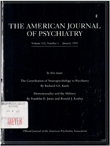Pathological laughing and crying following stroke: validation of a measurement scale and a double-blind treatment study
Abstract
OBJECTIVE: This study was undertaken to test the reliability and validity of the Pathological Laughter and Crying Scale and the effectiveness of nortriptyline treatment for patients with emotional lability following stroke. METHOD: Eighty-two patients with ischemic brain injury-54 who had been hospitalized with acute stroke and 28 others who requested treatment for pathological laughing and crying-- were given standardized psychiatric and neurological assessments and then administered the Pathological Laughter and Crying Scale. The 54 acute stroke patients were used to evaluate the Pathological Laughter and Crying Scale, and the 28 patients with pathological emotional display were randomly assigned to nortriptyline treatment or placebo in a 6-week double-blind trial to assess the efficacy of a tricyclic antidepressant in treatment of this disorder. RESULTS: The interrater reliability on the Pathological Laughter and Crying Scale for a subgroup of 15 patients was 0.93, and the test-retest reliability of the scale was excellent. After 4 and 6 weeks of treatment, scores on the Pathological Laughter and Crying Scale showed significantly greater improvement in the 14 patients given nortriptyline than in the 14 given placebo. Although almost one-half of these patients also had major depression, the improvement in emotional lability was independent of depression status. In addition, response to treatment was not significantly affected by lesion location or time since stroke. CONCLUSIONS: The severity of symptoms in pathological emotional display can be reliably quantified with the Pathological Laughter and Crying Scale, and treatment with nortriptyline can effectively ameliorate this emotional disorder.
Access content
To read the fulltext, please use one of the options below to sign in or purchase access.- Personal login
- Institutional Login
- Sign in via OpenAthens
- Register for access
-
Please login/register if you wish to pair your device and check access availability.
Not a subscriber?
PsychiatryOnline subscription options offer access to the DSM-5 library, books, journals, CME, and patient resources. This all-in-one virtual library provides psychiatrists and mental health professionals with key resources for diagnosis, treatment, research, and professional development.
Need more help? PsychiatryOnline Customer Service may be reached by emailing [email protected] or by calling 800-368-5777 (in the U.S.) or 703-907-7322 (outside the U.S.).



